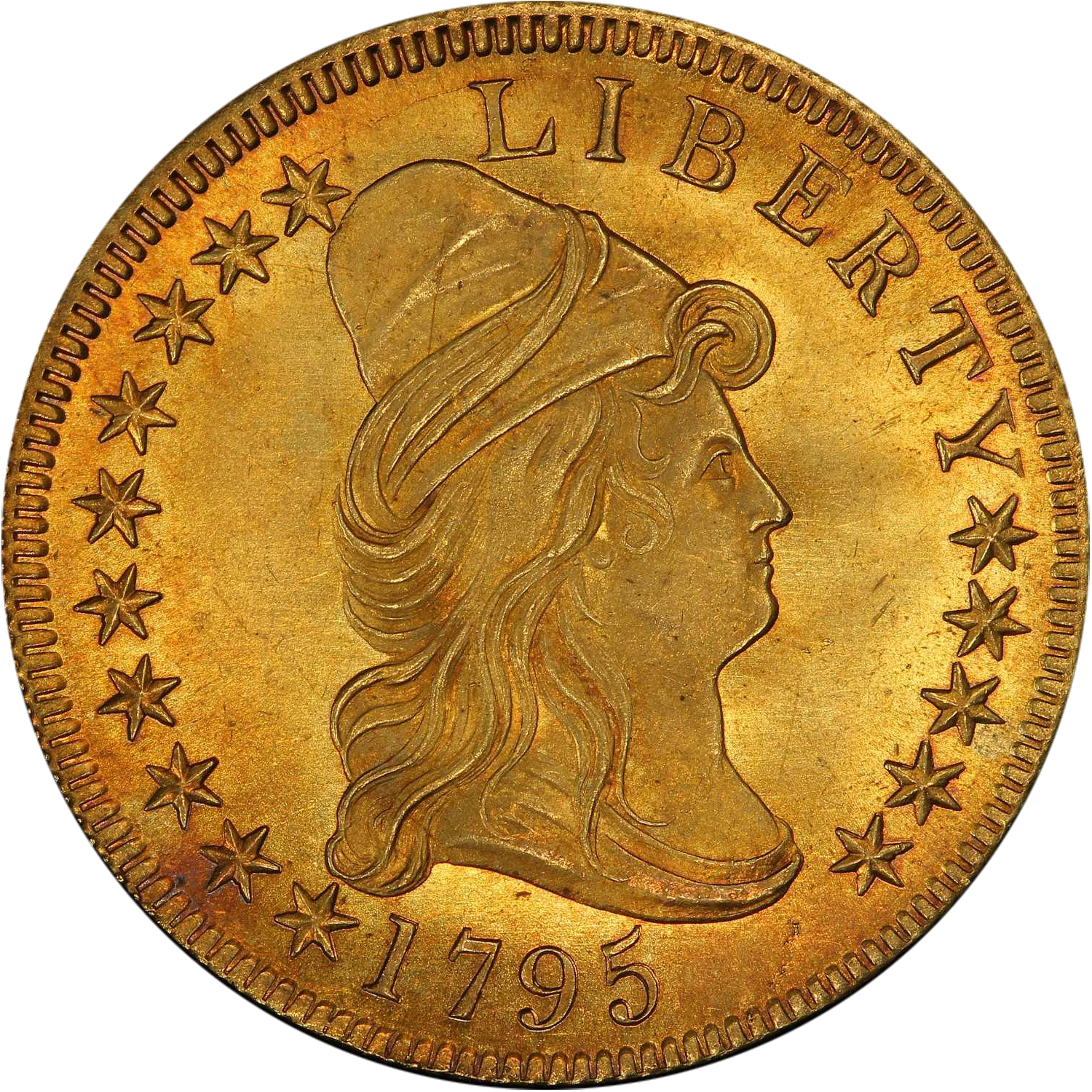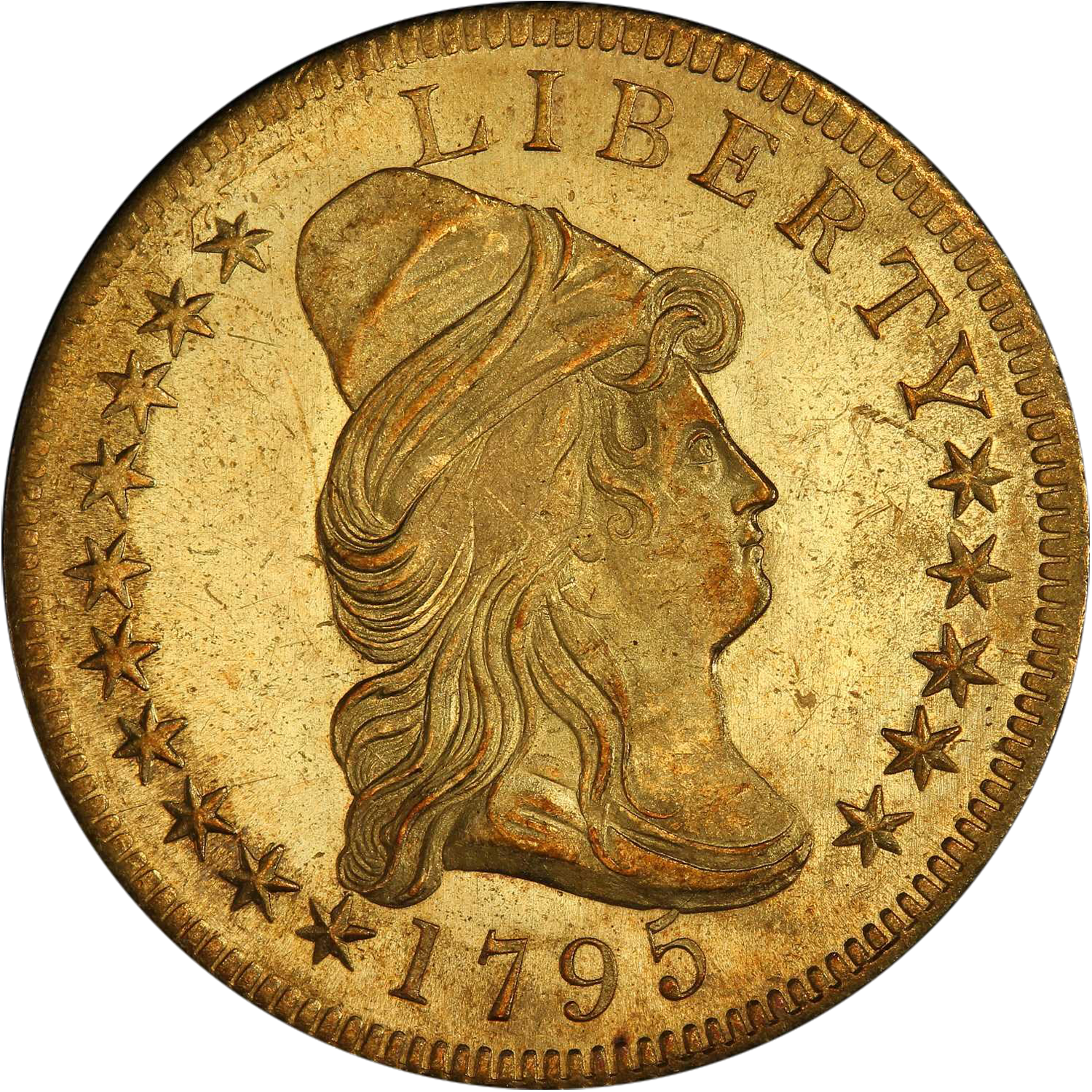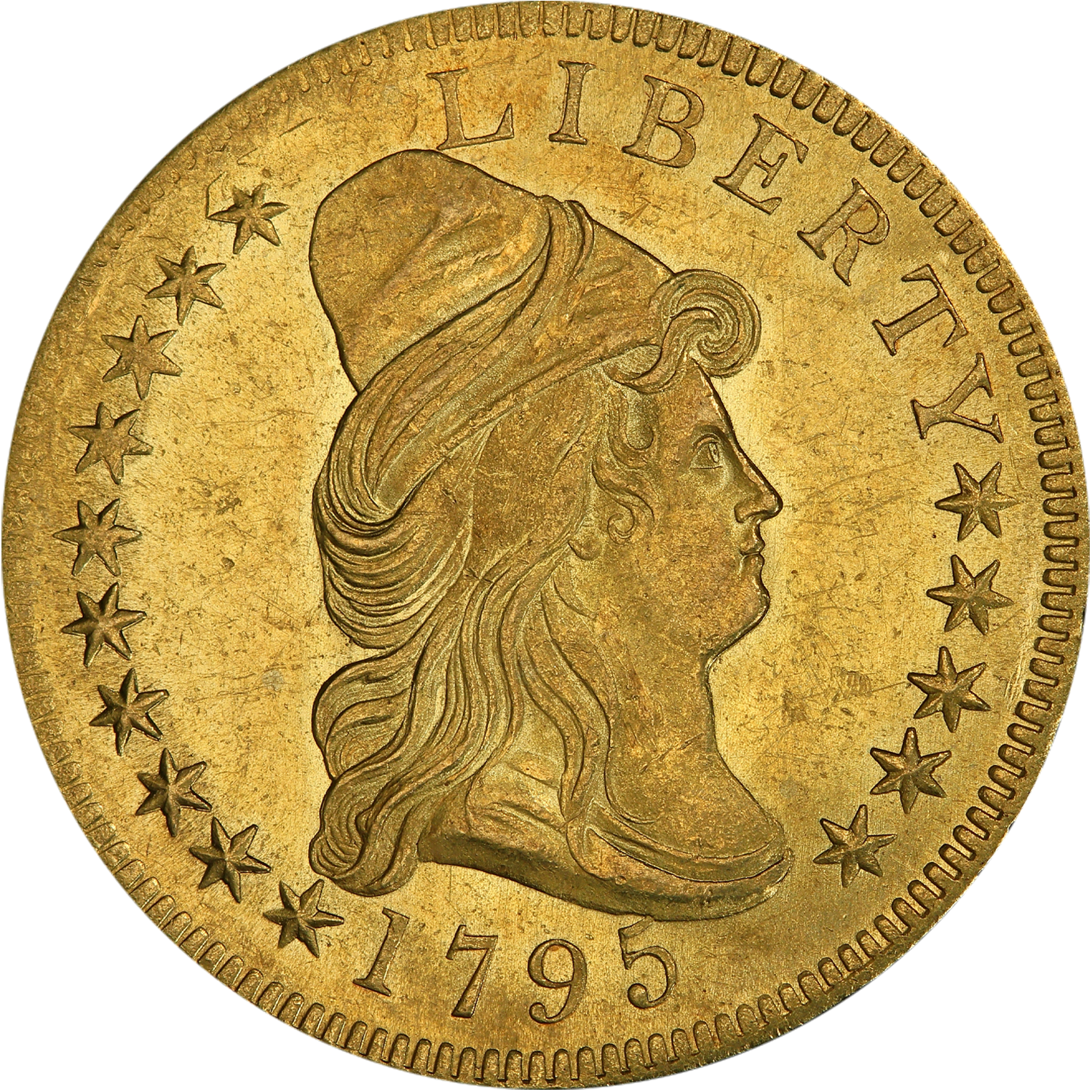1795 Capped Bust Right Eagle
13 Leaves
The large and impressive gold eagle served as the benchmark gold denomination for the fledgling United States' monetary system. Thirty-three millimeters in diameter, the first eagles made at the Philadelphia Mint are visually striking. Designed by Robert Scot, the Small Eagle reverse type was only used for three years and was replaced in 1797 by the Heraldic Eagle reverse. The mintage of 1795-dated examples is subject to debate; the number of eagles delivered during calendar year 1795 is recorded as 5,583 pieces, but this does not include the likelihood that a significant quantity of 1795-dated coins were also made in 1796. While this is the mintage figure that is generally reported for the date, detailed studies by John Dannreuther (published 2006) indicate that the actual mintage for all 1795-dated eagles is probably between 5,859 and 10,915 coins. Four of the five die marriages used bear a reverse that has 13 leaves on the palm frond held in the eagle's talons. The BD-1 die pair, as here, is characterized by having the obverse die where the tip of the digit 5 in the date overlays the bottom of the bust, while on the reverse the eighth palm leaf is close to the letter U in UNITED. Dannreuther estimates that somewhere between 2,795 and 5,583 eagles were struck from this die pairing. With about 325 coins believed extant in all grades, BD-1 is the most available variety of the issue and enjoys strong demand from type collectors at all levels of preservation. (Spring 2023 Auction - U.S. Coins & Currency. Ended: March 24th, 2023 lot 3227)
"The eagle is not a very expressive or apt appellation for the largest gold piece, but nothing better occurs." -- Alexander Hamilton, ?On the Establishment of a Mint, 1791
The Mint Act of April 2, 1792, established the $10 gold coin, or eagle, as the United States' highest denomination. The first examples were struck in 1795, arguably the most historically significant gold coins struck in the United States Mint. Although the 1795 Small Eagle $5 was the first gold coin struck by the United States Mint (in late July), no other coin symbolizes the aspirations of the nation and the American economy like the 1795 eagle. It was an ambitious denomination, first conceived by Thomas Jefferson, the author of most initial underpinnings of the American coinage system. Then serving as one of Virginia's delegates to Congress, Jefferson described the eagle for the first time in his Notes on the Establishment of a Money Unit and of a Coinage for the United States, popularly known as his "Notes on Coinage," written in the spring of 1784. After explaining why the money unit should be pegged to the familiar Spanish milled dollar and why a decimal-based system is easier for both natives and foreigners, Jefferson suggested: "If we adopt the dollar for our unit, we should strike four coins, one of gold, two of silver, and one of copper, viz. 1. a golden piece equal in value to 10 dollars, 2. the unit or dollar itself of silver, 3. the tenth of a dollar, of silver also, 4. the hundredth of a dollar of copper." He further explored his "golden piece" in terms of two coins then common in the cash boxes of American merchants, the first made in mints in Portugal and Brazil, the second a standard English gold coin, noting that the eagle "will be 1/5 more than a half Joe and 1/15 more than a double guinea. It will be readily estimated then by reference to either of them, but more readily and accurately as equal to 10 dollars."
Jefferson did not coin the name "eagle" for his 10 dollar denomination. In May 1785, Jefferson submitted his Propositions Respecting the Coinage of Gold, Silver, and Copper, in which he referred to the largest gold coin of the newly independent republic as the "crown," an ironic choice that first appears in Gouverneur Morris' 1783 writings regarding a very different coinage scheme. Jefferson was not terribly fond of the title, as he remarked "as to the names above chosen, they, like all other names, are arbitrary, and better may perhaps be substituted." A letter from Jefferson to William Carmichael, dated November 4, 1785, reveals that the question of denominations had still not been decided. Virginia delegate James Monroe reported to Jefferson, then in Paris, in January 1786 that "the subject of the mint...will be taken up again so soon as we have 9 or 10 states (for at present we have but 7)." It took eight more months, but Congress finally came to a resolution on a coinage system on August 8, 1786, declaring that the coin "equal to ten dollars, to be stamped with the impression of the American eagle [would] be called An Eagle."
Not everyone loved the name. Edmund Pendleton, a Virginia planter and politician, wrote to James Madison in December 1786 to complain about the new federal government prerogative to coin money, a power formerly held by the states. He preferred the former system by which the central government merely regulated the value of the coins then circulating, "leaving it to each [state] to coin any bullion they might fortunately meet with at home and in such pieces as their convenience should direct, whether in Eagles or Sparrows, so they conformed to the rules prescribed." Alexander Hamilton, befitting his reputation, was more direct, writing in his 1791 report "On the Establishment of a Mint" that "the eagle is not a very expressive or apt appellation for the largest gold piece, but nothing better occurs." Thus, the name remained, as did the denomination, first struck in September 1795 and last coined in 1933.
The first eagles are large and impressive coins, measuring approximately 33 millimeters and weighing 17.50 grams. The composition is an alloy of .9167 gold and .0833 silver and copper. These standards for size, weight and composition would remain current until Jefferson, then as president, halted eagle production in 1804. When coinage of this denomination resumed in 1838, the coins were smaller, lighter and made of an alloy of .900 gold and .100 copper, per the Coinage Act of June 28, 1834.
Numismatists have long referred to the design of the United States Mint's first eagles as the Capped Bust Right, Small Eagle, this type the work of Robert Scot, first chief engraver of the United States Mint. However, as Capped Bust is also the popular name of a different style introduced by John Reich on silver coins in 1807, it has been suggested that another name such as Conical Cap Right be used. The obverse depicts a draped bust of Liberty facing right with flowing hair and a turban-like cap. The word LIBERTY is above, the date is below and, depending on the date of the specific coin in question, 15, 16 or 13 stars are arranged around the border. The reverse design, which is particularly elegant, features an eagle with outstretched wings grasping a palm branch in its talons and a wreath without berries in its beak. The legend UNITED STATES OF AMERICA is around the border, the tips of the eagle's wings intruding into the lettering.
There is no expression of the denomination on either side of these early eagles, whose value was determined based on the precious metal content and weight. In fact, to speak of the early eagle as a denomination is actually a misnomer for, as Dannreuther states, "Even though a gold eagle was denominated as a ten-dollar coin, our forefathers traded gold by the tale...Tale, in this instance, means count or tally, the number of things taken together (i.e., the weight and purity of an individual coin)." Scot's design is said (by Walter Breen) to have been copied from an ancient cameo, perhaps explaining the use of a palm branch on the reverse, otherwise unusual.
Scot's Capped Bust Right obverse, Small Eagle reverse motif combination was only used on eagles dated 1795, 1796 and 1797. The total mintage for this type is estimated at 10,609 to 18,676 pieces (per Dannreuther). A word on mintages for early U.S. Mint coins is perhaps in order here. The figures provided in government archives represent the number of examples struck in any given calendar year, but do not necessarily correspond to the number of coins struck from dies bearing that date. The early United States Mint experienced considerable difficulty procuring high quality steel for making dies. Functional dies, therefore, were often used until they failed, even if the date on the coins did not match the calendar year. Additionally, early U.S. Mint gold and silver coins were not struck on government account but, rather, at the request of bullion depositors who requested coins of a certain denomination in exchange for their precious metal. When they received a new warrant for coinage, Mint personnel often utilized whatever functional dies were at hand to fill that warrant, again without regard for whether the date on the coins being struck matched the calendar year. With these facts in mind, numismatic scholars have had to estimate the number of coins struck for individual issues and varieties in the early eagle series based primarily on the number of coins extant, of course with consideration for the yearly mintage figures provided in Mint records. In fact, Dannreuther's estimate of 10,609 to 18,676 Capped Bust Right, Small Eagle tens produced encompasses the total of 13,344 coins struck provided in the Guide Book of United States Coins(the Red Book), the latter of which is based more closely on yearly mintage figures as reported in Mint records.
Attrition for early eagles of 1795 to 1804 was extremely high. Although it is likely that some pieces circulated in commerce in the 1790s, afterward many if not most were exported and melted. Indeed, the exportation of eagles and the subsequent loss of gold had become so great by the earliest years of the 19th century that President Thomas Jefferson halted production of this denomination in 1804. Coinage did not resume until 1838; in the intervening years the half eagle was the highest denomination U.S. coin. The coinage of silver dollars, the highest silver denomination, was stopped as well (and did not resume until 1836). Most numismatic scholars believe that fewer than 1% of early eagles struck have survived to the present day. All dates and varieties in this series are scarce, and some are exceedingly rare.
(The Winter 2022 Auction. Ended: November 9th, 2022, lot 4001)
No gold denomination was coined longer than the $10, the key large denomination in Thomas Jefferson's decimal coinage scheme. Proposals for the eagle began in 1784 and were codified into law in 1786. The issuance of this denomination was one of the few things Jefferson and Hamilton ever agreed upon. It can be recalled that Jefferson famously put a bust of Hamilton in his home at Monticello across the room from a bust of himself so the two men could be "opposed in death as they were in life." The longest gap in its production was that between 1804 and 1834; the issuance of the denomination recommenced for circulation in 1838.
The example to the left was sold by Stack's Bowers Galleries in the D. Brent Pogue Part II Auction, where it realized $2,585,000.
1795 Capped Bust Right Eagle Auction Highlights
 PCGS MS-66+ Sold for $2,585,000 View Lot 2092 |  PCGS MS-63+ Sold for $1,057,500 View Lot 2091 |  PCGS MS-63 Sold for $630,000 View Lot 4004 |






